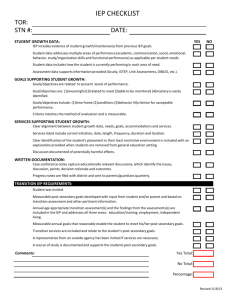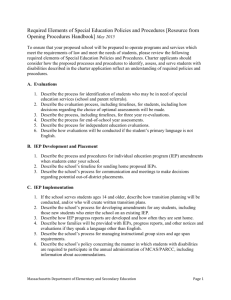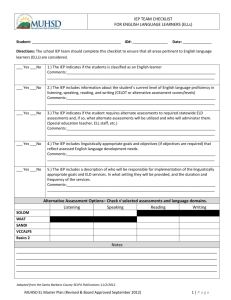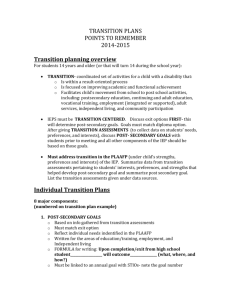Special Education Teacher Guiding Document for Evidence Report
advertisement
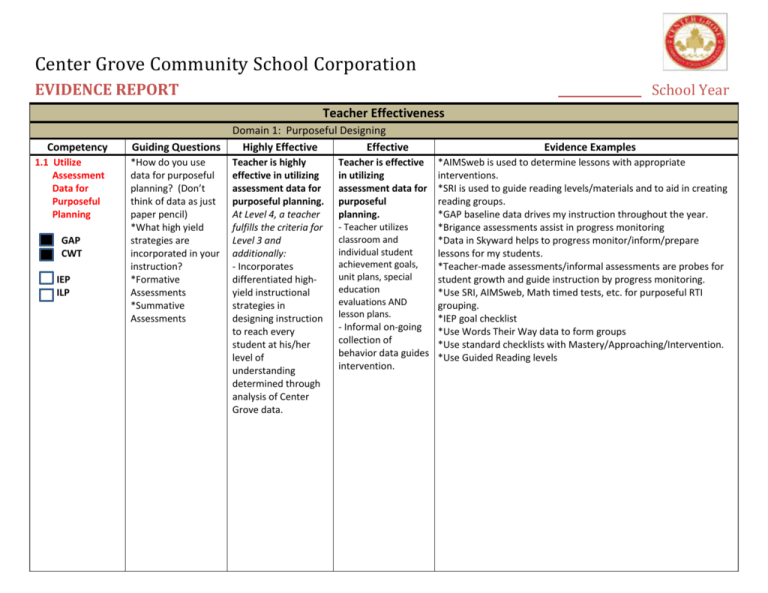
Center Grove Community School Corporation EVIDENCE REPORT School Year Teacher Effectiveness Competency Guiding Questions 1.1 Utilize Assessment Data for Purposeful Planning *How do you use data for purposeful planning? (Don’t think of data as just paper pencil) *What high yield strategies are incorporated in your instruction? *Formative Assessments *Summative Assessments GAP CWT IEP ILP Domain 1: Purposeful Designing Highly Effective Effective Teacher is highly effective in utilizing assessment data for purposeful planning. At Level 4, a teacher fulfills the criteria for Level 3 and additionally: - Incorporates differentiated highyield instructional strategies in designing instruction to reach every student at his/her level of understanding determined through analysis of Center Grove data. Teacher is effective in utilizing assessment data for purposeful planning. - Teacher utilizes classroom and individual student achievement goals, unit plans, special education evaluations AND lesson plans. - Informal on-going collection of behavior data guides intervention. Evidence Examples *AIMSweb is used to determine lessons with appropriate interventions. *SRI is used to guide reading levels/materials and to aid in creating reading groups. *GAP baseline data drives my instruction throughout the year. *Brigance assessments assist in progress monitoring *Data in Skyward helps to progress monitor/inform/prepare lessons for my students. *Teacher-made assessments/informal assessments are probes for student growth and guide instruction by progress monitoring. *Use SRI, AIMSweb, Math timed tests, etc. for purposeful RTI grouping. *IEP goal checklist *Use Words Their Way data to form groups *Use standard checklists with Mastery/Approaching/Intervention. *Use Guided Reading levels Rubric For Teacher Effectiveness 1.2 Set Measurable Achievement Goals GAP CWT IEP ILP *Use of standards and objectives *Know your standards, benchmarks at your level/content (Push-ups, SRI, etc.) Teacher is highly effective in setting measurable achievement goals. At Level 4, a teacher fulfills the criteria for Level 3 and additionally: - Plans individual student achievement goals and/or collaborative goals. Teacher is effective in setting measurable achievement goals. - Goals are measurable. - Goals are aligned to content standards; AND Goals include benchmarks to help monitor learning and discern appropriate interventions throughout the year. *IEP Compliance Checklist (Formal) *Present Levels: - Is there information regarding academic and functional achievement? - Does the PLOP support the LRE placement? *Behavioral Considerations: - Are there stated behavioral concerns? *Measurable Annual Goals: - Are the goals measurable? - Do the goals reflect the PLOP? *Special Education Services: - Are the services outlined? - Is it clear where the services are being delivered? What setting? *Accommodations: - Do the accommodations match PLOP needs? *Teacher/Student shared conferring pages (Informal) *IEP Data – progress on goals/student growth in 1 year. *Student Data Sheets (daily, weekly, etc.) *Data folders that students share ownership in *Bookmark, etc. of reading level goals *”Math Card” of math skills progress 2|P a g e Rubric For Teacher Effectiveness 1.3 Develop StandardsBased Unit Plans and Assessments GAPAP CWT IEP ILP *When planning do you begin with your assessment based on your standards and then plan daily lessons (Backwards Planning) *How do you incorporate differentiated instruction? *Does the standard you are using align with the End of Year/Course/Unit Assessment? Teacher is highly effective in developing standards-based unit plans and assessments. At Level 4, a teacher fulfills the criteria for Level 3 and additionally: - Creates well-designed unit assessments that align with an end of year summative assessment (either state, district, or teacher created). - Aligns lesson/unit assessments with ongoing frequent formative assessments. - Anticipates student reaction to content; allocation of time per unit is flexible and/or reflects level of difficulty of each unit. Teacher is effective in developing standardsbased unit plans and assessments. - Teacher identifies content standards that students will master in each unit. - Teacher creates assessments before each unit begins for backwards planning. - Teacher allocates an instructionally appropriate amount of time for each unit. - Teacher differentiates instruction based on student needs and learning styles. *Instruction is based on standard aligned to curriculum provided by the cooperating teacher/gen ed teacher. *Plans/designs lessons and/or assessment with gen ed teacher. *Gen ed classroom/spec ed classroom communication and cohesiveness. i.e. work from spec ed carried over smoothly into gen ed (book for independent reading/word work, etc.) *Instructional time is based on developmental level of child. *Interest inventories provide information for engagement and motivation of each individual student. *Student self-reflection on standards. *Task analysis is utilized to monitor student progress towards success of summative assessment. *Formative assessments are used throughout daily instruction. (make a list w/teacher) *Exit slips *Lesson plans with evidence of accommodations, re-teaching, etc. *Communication w/IAS, re: plans, etc. 3|P a g e Rubric For Teacher Effectiveness 1.4 Create Objective/GoalDriven Lesson Plans and Assessments GAP CWT IEP ILP *How do you use HighYield Strategies in your room? *How do you use Formative Assessments to drive your instruction? *Does your posted objective match one of your standards? Teacher is highly effective in creating objective/goal-driven lesson plans and assessments. At Level 4, a teacher fulfills the criteria for Level 3 and additionally: - Plans for a variety of differentiated high-yield instructional strategies, anticipating where these will be needed to enhance instruction. -Incorporates a variety of informal assessments/checks for understanding as well as summative CG assessments where necessary and uses all assessments to directly inform instruction. Teacher is effective in *Additional interventions are utilized when student creating objective/goal- misconceptions are anticipated. driven lesson plans and *Formative assessments are used throughout daily assessments. instruction. - Teacher identifies *Read-Aloud informal checklists. lesson objectives/goals *Manipulatives & Visuals available for multiple that are aligned to state representations and explanations. content standards. *Conferring based on skill development. - Teacher matches high*Lesson plans with evidence of accommodations, yield instructional re-teaching, etc. strategies as well as *Communication w/IAS, re: plans, etc. meaningful and relevant *PD high yield strategies. activities/assignments to the lesson objective/goals. - Teacher plans formative assessments to measure progress towards mastery or inform instruction. 4|P a g e Rubric For Teacher Effectiveness 1.5 Track Student Data and Analyze Progress GAP CWT IEP ILP *How do you use informal data points? *How do you use data to design future lessons or instruction? *Do you communicate student needs and progress regarding data points. *How do you track data? *How and how often do you analyze classroom data? *Does your assessment reflect mastery of your standards? Teacher is highly effective in tracking student data and analyzing progress. At Level 4, a teacher fulfills the criteria for Level 3 and additionally: - Uses daily checks for understanding for additional data points. (informal assessments such as behavior charting, agenda completion, PBIS charts) - Uses data analysis of student progress to drive lesson designing. (flexible grouping, reduction or increase in supports) (Skyward, mid-terms, benchmark testing, analysis of behavior charting) - Utilizes two-way communication with all stakeholders to inform data results. (conferencing w/students, conferencing w/parents) Teacher is effective in tracking student data and analyzing progress. - Teacher records student assessment/ progress data. - Teacher analyzes student progress towards mastery and plans future lessons/units accordingly. - Maintains and monitors a grading system aligned to learning goals. *Intervention, groups, amount of support change throughout year based on data analysis. *Data for reporting progress on goals – then evidence of what happens when data is analyzed. (change behavior plan, modified questions, etc.) *Daily notebook communication w/parents (elementary). *Data sweeps – data compares student to peers – are we closing the gap? *Data analysis for lesson designing – literacy partners, math partners, enrichment/remediation needs. *Analyzing SRI Reports/comparing to national growth charts. *Analyzing percent growth on AIMSweb. *Updated data folders 5|P a g e Rubric For Teacher Effectiveness Teacher Effectiveness Competency 2.1 Develop student understanding and mastery of lesson objective /goals GAP CWT IEP ILP Guiding Questions *Do your students understand WHY they are learning the material you present? *How do you activate prior knowledge in your students so they see connections to other curricula? *How do you organize your lessons to ensure that students are moving forward? *Does your objective state what students will learn and what they’ll be able to do at the end of the lesson? *How do you emphasize the objective of the day? (PPT, discussion, questioning) Domain 2: Effective Instruction Highly Effective Effective Teacher is highly effective in developing student understanding and mastery of lesson objective/ goals. For Level 4, all of the evidence listed under Level 3 is present, as well as some of the following: - Students can explain what they are learning and why it is important, beyond repeating the posted objective/goal. - Teacher effectively engages prior knowledge of students in connecting to lesson. Students demonstrate through work or comments that they understand this connection. Samples: class discussion, KWL chart, pre-tests, Fist of 5, Knowledge rating visual, advance organizer (HYS). Teacher is effective in developing student understanding and mastery of lesson objective/ goals. - Lesson is well-organized to move students towards mastery of the objective/goal. (flow, pace, engagement, length of instruction, materials available, classroom assistants are engaged w/students) -Agenda available and followed. - The posted lesson objective/goal is specific, measurable, aligned to standards, and engaging. It conveys what students are learning and what they will be able to do by the end of the lesson. (if not observed – take picture) - Importance of the objective/goal is explained so that students understand why they are learning what they are learning and how it connects to prior learning. Evidence Examples *Daily agendas in kid friendly language. *Individual teachers should have a system for monitoring mastery of grade-level standards and/or IEP goals. *Student self-reflection of lessons…could move post-it of mini-lesson from one column to another. (Column examples: have questions/I kind of get it/I get it). *Morning message”/”bell ringer”. *Forming skill and strategy small groups. *Standards check lists. 6|P a g e Rubric For Teacher Effectiveness 2.2 Engage students in the academic content GAP CWT IEP ILP *How does your instruction engage students to promote the objective of the day/Year? *What different strategies do you use to engage your students? *How do you make sure that students are authentically engaged the majority of the time? *How do you foster a student’s desire to learn more than what is presented? *How do you integrate technology into your instruction? Teacher is highly effective in engaging students in the academic content. For Level 4, all of the evidence listed under Level 3 is present, as well as some of the following: - Teacher provides ways to engage with content that significantly promotes student mastery of the objective/goal. - Teacher provides differentiated ways of engaging with content specific to individual student needs. - Students are authentically engaged the majority of the class time. Some strategic compliance occurs. Teacher is effective in engaging students in the academic content. - Teacher provides multiple ways (different learning modalities or intelligences) of engaging students with content, all aligned to the lesson objective/goal. - Students exhibit a desire to learn more; sustained engagement leads to profound learning. (Activities based on interests, student choice boards) - Teacher effectively integrates technology where appropriate and available as a tool to engage students in academic content. (with clear purpose) - Students are exhibiting Strategic Compliance the majority of the time with some Authentic Engagement and/or Ritual Compliance. *Use of small group, individual instruction. *Use of individual contracts/plans – can be for behavior or academics. *Appropriate use of technology. *Centers, visual, auditory, technology, manipulatives, concrete, abstract. *Evidence of using materials that complement student learning styles. *Student ownership. *Student Choice. *Multiple Intelligences *Students generating questions. *Lesson extended/adjusted for student interest. *Sensory breaks. *Brain-based learning (accessing 5 memory lanes, brain break). 7|P a g e Rubric For Teacher Effectiveness 2.3 Exhibit Knowledge of Content GAP CWT IEP ILP *How does your instruction engage students to promote the objective of the day/Year? *What different strategies do you use to engage your students? *How do you make sure that students are authentically engaged the majority of the time? *How do you foster a student’s desire to learn more than what is presented? *How do you integrate technology into your instruction? Teacher is highly effective in exhibiting knowledge of content. For Level 4, all of the evidence listed under Level 3 is present, as well as some of the following: - Teacher’s plans and practices reflect understanding of prerequisite relationships among topics and concepts and a link to necessary cognitive structures by students to ensure understanding. - Teacher’s plans and practice reflect familiarity with a wide range of effective pedagogical approaches in the discipline, anticipating student misconceptions. - Teacher continues to pursue content knowledge. Professional Development (books, articles, websites, conferences, workshops, afterschool offerings) Teacher is effective in exhibiting knowledge of content. - Teacher’s plans and practice reflect accurate understanding of prerequisite relationships among topics and concepts. - Teacher’s plans and practice reflect familiarity with a wide range of effective pedagogical approaches in the discipline. *Curriculum map or scope & sequence from gen ed teacher showing support of prerequisite relationships among topics and concepts. *SST process. *Evidence based strategies are continually used to address student needs. *Behavior Plan, FBA expertise. *Toolbox: behavior charting, creating incentive opportunities based on motivation, High yield strategies. *Non-violent crisis training. *Special content such as compliance laws, methodologies. 8|P a g e Rubric For Teacher Effectiveness 2.4 Check for Understanding and Modify Instruction As Needed GAP CWT IEP ILP *How do you incorporate higher levels of Bloom’s in your instruction? *How do you encourage more open-ended questioning during your lessons? *How do you provide scaffolding in your lessons? *What different forms of assessment do you use? *How do you make “inflight” corrections to further student understanding? *What is your process for WAIT TIME during class discussions and questioning? *How do you collaborate with gen ed teacher to meet the needs of ALL your students? Teacher is highly effective in checking for understanding and modifying instruction as needed. For Level 4, all of the evidence listed under Level 3 is present, as well as some of the following: - Teacher checks for understanding at higher levels by asking pertinent, scaffolding questions that push thinking - Teacher uses openended questions to surface common misunderstandings and assess student mastery of material at a range of both lower and higherorder thinking. - Teacher anticipates student misunderstandings and preemptively addresses them. - Teacher is able to modify instruction to respond to misunderstandings without taking away from the flow of the lesson or losing engagement. (pace, flow, focus) Teacher is effective in checking for understanding and modifying instruction as needed. - Teacher checks for understanding, using a variety of methods (when checking is necessary to inform instruction) - Teacher gains enough information during checks for understanding to modify the lesson and respond accordingly, differentiating to meet diverse student needs. - Teacher uses wait time effectively both after posing a question and before helping students think through a response. - Teacher routinely assesses students’ mastery of the objective/goal(s) through formal or informal assessments. - Teacher responds to misunderstandings with effective scaffolding techniques. -Teacher collaborates with ENL, Speech, Gen Ed and Special Education teachers in inclusive or resource settings in order to implement students’ IEPs effectively. *Use of visual supports. *Formative assessments, daily informal checks. *Scaffolding techniques. *CWT or statement regarding general practice. *Evidence is the actual assessment. *Show modification/accommodation. *E-mail, minutes from meeting 9|P a g e Rubric For Teacher Effectiveness 2.5 Maximize Instructional Time GAP CWT IEP ILP *What techniques do you use for transitions, procedures, and routines? *Do students own and help in these procedures to help manage the classroom? *Does your class run itself based on the procedures you have put in place? *How do you handle discipline problems during a lesson? *Are you prepared to begin class when your students arrive? Teacher is highly effective in maximizing instructional time. For Level 4, all of the evidence listed under Level 3 is present, as well as some of the following: - Routines, transitions, and procedures are well executed. Students know what they are supposed to be doing and when without prompting from the teacher. - Students are always engaged in meaningful work while waiting for the teacher (for example, during attendance). - Students share responsibility for operations and routines and work well together to accomplish these tasks. (student led process) - All students are on-task and follow instructions of teacher without much prompting. - Disruptive behaviors and off-task conversations are rare; when they occur, they are always addressed without major interruption to the lesson. Teacher is effective in maximizing instructional time. - Class starts on time. - Teacher’s procedures generally cause students to arrive on time, and students are aware of the consequences of arriving late (unexcused). - Routines, transitions, and procedures are wellexecuted. Students know what they are supposed to be doing and when with minimal prompting from the teacher. - Teacher delegates time between parts of the lesson appropriately so as best to lead students towards mastery of objective/goal. - Almost all students are on-task and follow instructions of teacher without much prompting. - Disruptive behaviors and off-task conversations are rare; when they occur, they are almost always addressed without major interruption to the lesson. *Visual schedules for procedures. *Role play. *Train – Explicitly taught procedures and routines. *Anchor charts, posters w/routines. *”Morning message” or entering-the-room routine. *Evidence of routine and classroom management. *Workstations/”I can” charts. *Purposeful “finished early” tasks. *Lesson plan shows processing time and practice. *Very little “down” time – sense of positive urgency. *Engagement. *Procedure used for classroom management – picture of class management system, office referrals, d-slips. *This area is going to be more common with sp ed students, there WILL be interruptions. Most important would be use of effective behavior plans, does crisis team plan work, can teacher/IA able to de-escalate situations, read student behavior to prevent escalations, etc. *Does student know how to self-advocate and ask for breaks, etc? *Social skill instruction: was case conference reconvened? Did student support team meet? 10 | P a g e Rubric For Teacher Effectiveness 2.6 Create classroom Culture of Respect and Collaboration GAP CWT IEP ILP What do you do to encourage students to care about and support each other? *What can you put into place so students selfmonitor in the classroom? *Do you allow students opportunity to collaborate? *Do you have a Positive Behavior Support system in place and posted? *How do you balance this with consequences? *Do you have good relationships with your students? *How do you show that you are empathetic and caring towards your students? *How do you know that your students feel like they have a voice with you? Teacher is highly effective in creating a classroom culture of respect and collaboration. For Level 4, all of the evidence listed under Level 3 is present, as well as some of the following: - Students are invested in the academic success of their peers as evidenced by unprompted collaboration and assistance. (“catch’em being good” log) - Students reinforce positive character and behavior and discourage negative behavior amongst themselves. (PBSS) Teacher is effective in creating a classroom culture of respect and collaboration. - Students are respectful of their teacher and peers. - Students are given opportunities to collaborate and support each other in the learning process. - Teacher reinforces positive character and behavior and uses consequences appropriately to discourage negative behavior. - Teacher has a good rapport with students and positive relationships are built. - Teacher is empathetic and caring toward students. - Students are listened to, are involved with twoway sharing with the teacher, and are active participants in the learning which is tied to their thoughts and interests. *Teacher expectation is to address all adults and students with proper salutations. *Students have ownership in group/class expectations (may even sign a contract) – visibly posted in room. *Mentor texts used to teach/respect expectations. (Elmer and Mr. Peabody’s Apples) *Teacher communication tool established. *Lesson Plans *High yield strategies – cooperative learning. *PBSS, behavior charting, motivation techniques *Intrinsic & Extrinsic motivation for both personal and team accomplishments. *Discussions, comfortable and willing to ask questions. Survey for student opinion. *Evidence will overlap with 2.5. 11 | P a g e Rubric For Teacher Effectiveness 2.7 Set High Expectations for Academic Success and Develops Higher Levels of Understanding through Instruction and Work GAP CWT IEP ILP *How do you ensure that ALL learners in your room can be successful? *How do you remediate or enrich your lessons? *How do your students demonstrate that they value what you are teaching? *How do you instill persistence in your students? *What do you do to create a safe and caring classroom? *What do you do to set HIGH EXPECTATIONS for all learners in your class? Teacher is highly effective in setting high expectations for all students and for developing higher levels of understanding across all concepts. For Level 4, all of the evidence listed under Level 3 is present, as well as some of the following: - Daily lessons are accessible for all, challenging to all, and encourage all students to demonstrate understanding through self-directed practice and application of concepts. - Teacher and lesson design encourage student interest in learning by providing additional opportunities to apply and build skills beyond expected lesson elements (i.e. co-planned enrichment pportunities). - Students’ comments and actions demonstrate that they are excited about their work, value cognitively challenging work, and understand why it is important. - Teacher demonstrates ability to build and facilitate student skill in answering and posing higher-level questions. Teacher is effective in setting high expectations for most students and developing higher levels of understanding of most concepts. - Lessons most often engage student participation and encourage much student persistence to demonstrate understanding. - Teacher and lesson design push almost all students forward through challenging work due to differentiation of instruction and individualized support. - The classroom is a safe and engaging learning environment where high expectations for all are the norm. - Teacher almost always uses questioning as the tool for increasing student understanding and demonstrates expertise in use of progressively complex levels of questioning. *Lesson plans differentiated. *Eager Beaver Anchor Assignment Extension Activity. *Teacher observes students excited about their work. *Exit slip. *On-task behavior charts. *Improved scores on assessments. *Amount of completed work. *Reaching goals. *Analysis of what level of support is needed – do they need this support? *Risk takers, free to ??. *Lesson plans. *CWT Bloom’s. *Quick pick reports. 12 | P a g e Rubric For Teacher Effectiveness Teacher Effectiveness Competency 3.1 Contribute to School/District Culture GAP CWT IEP ILP Highly Effective Domain 3: Teacher Leadership Effective Teacher is highly effective in contributing to school/district culture. At Level 4, a teacher fulfills the criteria for Level 3 as well as some of the following: - Teacher seeks out leadership roles in school and district. - Teacher frequently demonstrates commitment and dedicates time for students outside of regular classroom instruction. -Teacher develops mutually rewarding, positive relationships with peers. Teacher is effective in contributing to school/district culture. - Teacher takes on leadership willingly when asked. - Teacher often contributes ideas and expertise to further the school and district missions and initiatives. - Teacher dedicates time efficiently, when needed, to helping students outside of regular classroom instruction. - Teacher develops interpersonal, positive relationships with peers. Evidence *Sensory, attention, behavior expertise shared with gen ed. *Coffee shop - can be expanded to all levels to include student jobs – recycling, shredding, etc. *Participating in Jack’s Walk, Special Olympics, etc. *Before, after school, placing resources on teacher website. *Before school year starts, visits for families/students in elementary. *Serve on interview committees. *Work collaboratively with peers – emails. *Spec ed chairing conferences with each other and for speech therapists. 13 | P a g e Rubric For Teacher Effectiveness 3.2 Collaborate with Peers GAP CWT IEP ILP 3.3 Seek and Implement Professional Skills and Knowledge GAP CWT IEP ILP Teacher is highly effective in collaborating with peers. At Level 4, a teacher fulfills the criteria for Level 3 as well as some of the following: - Teacher almost always seeks out opportunities to collaborate. - Teacher takes on leadership roles and actively participates within collaborative groups. - Teacher initiates the sharing of educational strategies, content knowledge, or lesson plans with colleagues. Teacher is effective in collaborating w/ peers. - Teacher seeks out and participates in regular opportunities to work with and learn from others. - Teacher willingly coaches and models lessons. - Teacher asks for assistance and provides assistance to others when needed. - Teacher actively listens and collaborates with others. *Communicate regularly with gen ed teacher regarding assistant and student, strategies, content, etc. *Works with colleagues, Marcy, Kathy Stricker, Instructional Coach, Johnson County Special Services, workshops, and conferences. *Helps colleagues with lessons. *Collaborates with others at case conferences. Teacher is highly effective in seeking and implementing professional skills and knowledge. At Level 4, a teacher fulfills the criteria for Level 3 as well as some of the following: - Teacher regularly shares newly learned knowledge and practices with othersgrade/team, building, and district. -Teacher actively pursues opportunities to lead professional development activities at building and district levels. - Teacher has the willingness and capability for independent learning and researching of district practices and resources. -Teacher is a Leader of Leaders (trainer). Teacher is effective in seeking and implementing professional skills and knowledge. -Teacher actively pursues opportunities to improve knowledge and practice. - Teacher seeks out ways to implement new practices into instruction, where applicable. - Teacher welcomes constructive feedback to improve practices. - Teacher willingly learns about and seeks opportunities to learn about and research district practices and resources. *Informal modeling: grade level meeting, newsletter, email and website. *Serve on student support teams. *Consult with gen ed teachers to help non-sped students. *Participates in gen ed initiatives such as balanced literacy, etc. *Participates in PD opportunities. *Seeks/implements common core knowledge. *Risk-taker, tries new things. *E-mails, rough draft copies, request for reviewing documents. 14 | P a g e Rubric For Teacher Effectiveness 3.4 Advocate for Student Success GAP CWT IEP ILP 3.5 Communicating with Families GAP CWT IEP ILP Teacher is highly effective in advocating for student success. At Level 4, a teacher fulfills the criteria for Level 3 as well as some of the following: - Teacher displays commitment to the growth of all the students in the school and sees him/herself as accountable. - Teacher models a continued willingness to make changes to ensure student success. Teacher is effective in advocating for student success. - Teacher displays commitment to the education of all his/her students in his/her class. - Teacher attempts to remedy obstacles around student achievement. - Teacher frequently advocates for students' individualized needs. *IEP goals stretch student in a positive way. *Compliance of IEP. *PD on “Ladder of Needs”. *Conversation with gen ed teacher, counselor or administrator. *E-mail *Phone calls home. *Evolution of IEP, case conference agenda Teacher is highly effective in communicating with families. At Level 4, a teacher fulfills the criteria for Level 3 as well as some of the following: - Teacher strives to form relationships in which parents are given ample opportunity to participate in student learning. - Teacher addresses concerns in a timely and positive manner, when necessary, outside of required outreach events (P/T conferences, Meet the Teacher Nights, etc.). Teacher is effective in communicating with families. - Teacher proactively reaches out to parents in a variety of ways to engage them in student learning. -Teacher responds promptly to contact from parents in an appropriate fashion. - Teacher engages in all forms of parent outreach required by the school. *Newsletters, phone logs, emails, website, participation in events, Skyward. *E-mail dates, phone logs, Skyward log-in. *Back to school night, conferences *Take home folder. *”Home Journal” with daily notes via internet, journal *Aides, chaperones, organizers of activities. 15 | P a g e Rubric For Teacher Effectiveness Teacher Effectiveness Domain 4: Professionalism Competency 4.1 Attendance Meets Standard Individual demonstrates a pattern of meeting attendance guidelines. Evidence GAP CWT 4.2 On-Time Arrival Individual demonstrates a pattern of meeting arrival guidelines. GAP CWT 4.3 Policies, Procedures, and Expectations Individual demonstrates a pattern of following state, corporation, and school policies and procedures (e.g. submitting discipline referrals, timely grading records, supervision assignments, appropriate attire, etc.) *All IEP compliancy. *History in IIEP for progress on goals. Individual demonstrates a pattern of interacting with students, colleagues, parents/guardians, and community members in a respectful manner. *Administrators GAP CWT 4.4 Respect GAP CWT 4.5 District/Building Goals Individual demonstrates a pattern of implementing building and/or *Initiatives – Dis Ed, Reading Workshop, Step up to Writing district goals. *Utilize district purchased resources. *GAP Procedure – am I following? GAP CWT 16 | P a g e
